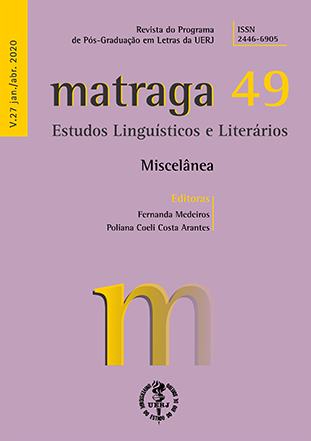Truth and meaning in the Speech Acts Theory: notes on the assumptions of the Searlean theory
DOI:
https://doi.org/10.12957/matraga.2020.44195Keywords:
Truth. Meaning, Speech Acts, John Searle.Abstract
Since its formulation in the first half of the twentieth century (AUSTIN, 1962), the Speech Acts Theory has been consolidated as a fruitful approach to understanding the relations between language and action. In this sense, we can observe, for example, the constant treatment of theory in the most varied language manuals on Pragmatics. Therefore, keeping in mind this privileged place that the theory has reached, despite its critics, and in order to make possible new incursions in the Speech Acts Theory or even in the whole John Searle’s philosophy of language and mind, the present article aims to shed light on the concepts of “meaning” and “truth” that underlie Speech Acts Theory of Searlean orientation. To this end, in addition to punctual statements by John Searle, we recall the considerations of Mari (1998), Strawson (1982) and Walker (1997). In conclusion, we maintain that at the basis of the Speech Acts Theory lies both the “correspondence theory of truth” and the understanding that meaning is the product of the complex relationships between the sentence’s conventional meaning (formal aspect) and the speaker’s intentional meaning (real aspect).
Downloads
Downloads
Published
How to Cite
Issue
Section
License
Authorization
Matraga – Scientific Journal of the Post-graduate Program in Arts and Humanities of UERJ is authorized to publish the article submitted here, if it is accepted for online publication. It is attested that the contribution is original, that it is not being submitted to another publisher for publication, and that this statement is the expression of truth.
The works published in Matraga's virtual space – Scientific Journal of the Post-graduate Program in Arts and Humanities of UERJ will be automatically transferred, and your copyright is reserved to Matraga. Its reproduction, in whole or in part, is conditional on the citation of the authors and the data of the publication.

Matraga uses license Creative Commons - Attribution-Non-Commercial 4.0 International.





